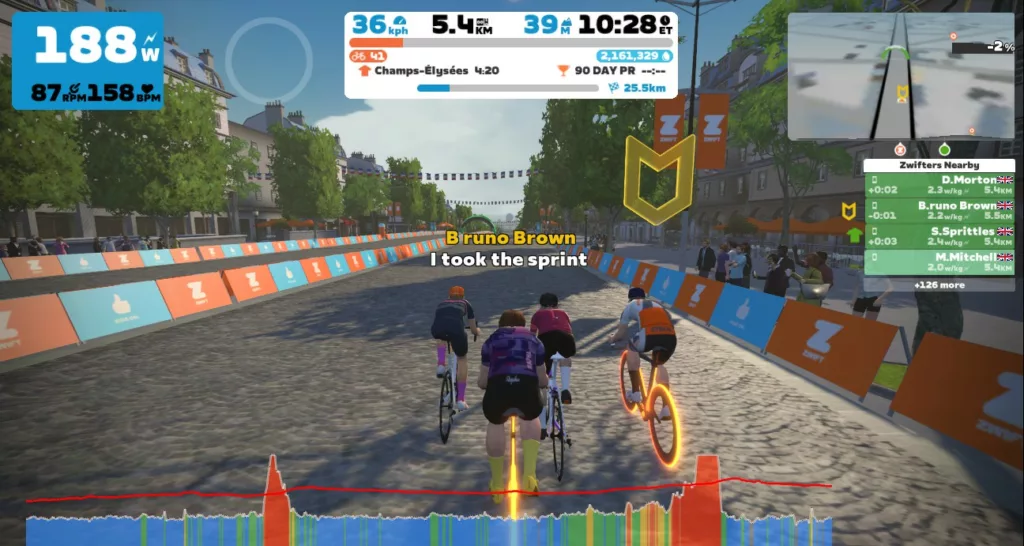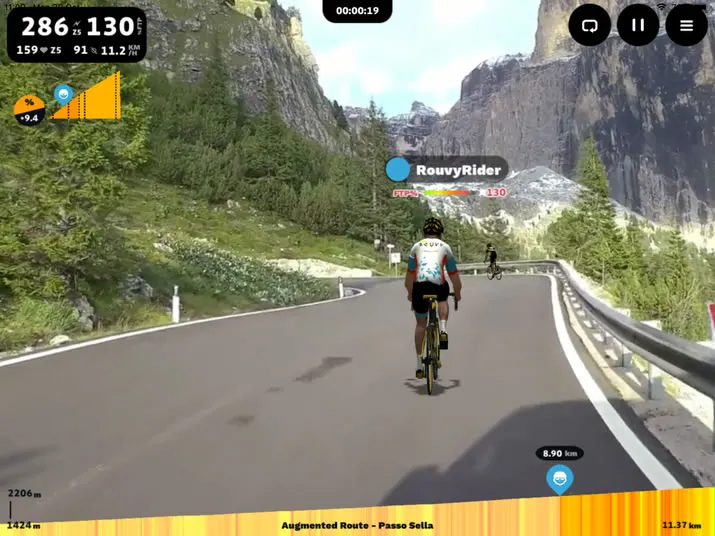In the realm of indoor cycling, Rouvy and Zwift are two leading platforms, each offering a unique set of features that cater to varying preferences and training objectives. This article delves into a thorough comparison of these platforms, examining aspects such as their distinct environments, training options, user interface, social aspects, pricing, and more. Rouvy is celebrated for its authentic augmented reality routes based on real locations, making it a favourite for cyclists who desire a realistic riding experience.
Table of Contents
ToggleIn contrast, Zwift is known for its lively, game-like virtual worlds, which are particularly appealing to those who enjoy a more interactive and community-oriented experience. This analysis covers everything from Rouvy’s extensive selection of real-world routes to the communal workouts and competitive events offered by Zwift. The aim is to provide an insightful guide for cycling enthusiasts to choose the platform that best suits their training style, whether they prefer solo rides or the camaraderie of a bustling cycling community.
Main Differences Between Rouvy and Zwift
Rouvy and Zwift are two popular indoor cycling platforms that offer unique experiences to their users. Rouvy is known for its realistic graphics and routes based on real-world locations. It uses augmented reality to overlay animated 3D objects onto real video footage, creating an immersive cycling experience. On the other hand, Zwift offers a more game-like experience with its virtual world, where cyclists can ride with others from around the globe.
Rouvy offers over 7,000 routes to choose from, which are based on real-world locations. These routes are created using GPS data and video footage, providing a realistic riding experience. Zwift, however, offers fewer routes but they are set in a variety of virtual worlds, including a futuristic city, a volcanic island, and a recreation of London.
In terms of training options, Rouvy provides structured workouts, training plans, and the ability to create custom workouts. Zwift also offers these features but adds the element of group workouts, where users can join others in completing the same workout.
Rouvy and Zwift also differ in their social interaction features. Rouvy is more focused on individual training and doesn’t offer as much social interaction. Zwift, however, has a strong social component with its group rides, races, and the ability to give “Ride Ons” to other cyclists.
Finally, the cost of the two platforms is also a significant difference. Rouvy is slightly cheaper than Zwift, but both platforms offer a free trial period for new users to test out their features.

User Interface Comparison Between Rouvy and Zwift
When it comes to the user interface, both Rouvy and Zwift have their strengths and weaknesses. Rouvy’s interface is straightforward and easy to navigate, with clear menus and options. The main screen displays your current ride data, including speed, power, and heart rate. It also shows a map of the route and the profile of the terrain. However, some users find the graphics to be less engaging than Zwift’s.
Zwift’s user interface is more game-like, with a colourful and engaging design. The main screen displays your avatar cycling in the virtual world, along with your ride data. There are also buttons for giving “Ride Ons” to other cyclists, taking screenshots, and using power-ups. However, some users find Zwift’s interface to be more cluttered and less intuitive than Rouvy’s.
In terms of customisation, both platforms allow users to customise their avatars and bikes. However, Zwift offers more options, including different kits, bikes, and accessories. Rouvy’s customisation options are more limited, focusing mainly on the bike and kit.
Both platforms also offer companion apps for smartphones, which provide additional features and controls. Rouvy’s app allows users to control their workouts, view ride data, and explore routes. Zwift’s app offers similar features, along with the ability to chat with other cyclists and join events.
Cost Comparison Between Rouvy and Zwift
The cost of Rouvy and Zwift is a significant factor for many users. Rouvy offers a monthly subscription for $10, or a yearly subscription for $100. This makes Rouvy slightly cheaper than Zwift, which costs $14.99 per month. However, both platforms offer a free trial period for new users to test out their features.
It’s also worth noting that both Rouvy and Zwift require additional hardware, such as a smart trainer or power meter, to use their platforms. These devices can be quite expensive, adding to the overall cost of using these platforms.
In terms of value for money, both platforms offer a wide range of features for their price. Rouvy offers over 7,000 real-world routes, structured workouts, and training plans. Zwift offers a variety of virtual worlds, group workouts, races, and social features.
Ultimately, the decision between Rouvy and Zwift may come down to personal preference and budget. Some users may prefer the realistic routes and lower cost of Rouvy, while others may prefer the social interaction and game-like experience of Zwift.

Training Options in Rouvy and Zwift
Both Rouvy and Zwift offer a variety of training options to help cyclists improve their fitness and performance. Rouvy provides structured workouts, training plans, and the ability to create custom workouts. The workouts are based on power zones, and users can choose from a library of workouts or create their own.
Rouvy also offers a unique feature called “Career Mode”, where users can earn points and level up by completing rides and workouts. This adds a gamification element to the platform, providing extra motivation to train.
Zwift also offers structured workouts and training plans, but adds the element of group workouts. In these workouts, users join others in completing the same workout, with everyone’s speed adjusted so they stay together. This creates a social and motivating training environment.
Zwift also offers races and events, which are a fun and competitive way to train. Users can join races against others from around the world, or participate in special events like charity rides or pro races.
Both platforms also offer the ability to ride freely on their routes, allowing users to train at their own pace and explore the virtual or real-world scenery.
Social Interaction in Rouvy and Zwift
Social interaction is a key feature of indoor cycling platforms, and both Rouvy and Zwift offer different ways for users to connect with others. Rouvy is more focused on individual training and doesn’t offer as much social interaction. However, users can still join races and events, and follow other users to see their rides and workouts.
Zwift, on the other hand, has a strong social component. Users can join group rides and races, chat with other cyclists, and give “Ride Ons” to show their support. Zwift also has clubs and teams, where users can join together to ride and compete.
Zwift’s social features are more interactive and engaging, making it a great choice for those who enjoy the social aspect of cycling. However, for those who prefer to train alone and focus on their workouts, Rouvy may be a better fit.

Graphics and Virtual Reality in Rouvy and Zwift
The graphics and virtual reality aspects of Rouvy and Zwift are another key difference between the two platforms. Rouvy uses augmented reality to overlay animated 3D objects onto real video footage, creating a realistic and immersive cycling experience. The routes are based on real-world locations, and users can even upload their own routes using GPS data and video footage.
Zwift, on the other hand, offers a more game-like experience with its virtual worlds. The graphics are colourful and engaging, and users can explore a variety of environments, including a futuristic city, a volcanic island, and a recreation of London. Zwift also offers a first-person view, which provides a more immersive riding experience.
While Rouvy’s graphics are more realistic, Zwift’s are more engaging and fun. The choice between the two may depend on whether you prefer a realistic or game-like cycling experience.
Hardware Requirements for Rouvy and Zwift
Both Rouvy and Zwift require additional hardware to use their platforms. At a minimum, users will need a bike, a trainer, and a device to run the app (such as a computer, tablet, or smartphone). For the best experience, a smart trainer or power meter is recommended, as these devices can provide accurate power data and allow for automatic resistance changes.
In terms of system requirements, both platforms are compatible with Windows, Mac, iOS, and Android devices. However, for the best performance and graphics, a newer and more powerful device is recommended.
It’s also worth noting that both platforms support ANT+ and Bluetooth sensors, allowing users to connect heart rate monitors, cadence sensors, and other devices.
Race Options in Rouvy and Zwift
Racing is a popular feature on indoor cycling platforms, and both Rouvy and Zwift offer a variety of race options. Rouvy offers time trial races, where users compete against the clock on a specific route. There are also challenge races, where users compete to complete a route in the fastest time over a certain period.
Zwift offers a wider variety of races, including criteriums, road races, time trials, and mountain bike races. There are also special events, like charity rides or pro races, where users can ride with professional cyclists.
Both platforms also offer leaderboards and rankings, allowing users to compare their performance with others. Zwift’s races are more interactive and social, with live chat and the ability to give “Ride Ons” to other cyclists. However, Rouvy’s races are more realistic, with routes based on real-world locations.

Community Size and Engagement in Rouvy and Zwift
The community size and engagement is another important factor to consider when choosing between Rouvy and Zwift. Zwift has a larger and more active community, with over 1 million registered users. There are also many clubs and teams, where users can join together to ride and compete.
Zwift’s community is very engaged, with regular group rides, races, and events. There is also a strong social element, with live chat and the ability to give “Ride Ons” to other cyclists.
Rouvy’s community is smaller but still active. Users can join races and events, and follow other users to see their rides and workouts. However, Rouvy’s social features are more limited, and the platform is more focused on individual training.
In conclusion, both Rouvy and Zwift offer unique experiences and features, and the best choice may depend on your personal preferences and goals. Whether you prefer the realistic routes of Rouvy or the social and game-like experience of Zwift, both platforms can provide an engaging and effective indoor cycling experience. For more information and tips on indoor cycling, check out our articles on ProCycling UK.






